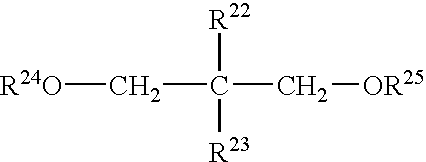Solid catalyst component and catalyst for olefin polymerization, and process for producing olefin polymer
a technology of solid catalyst and polymerization, which is applied in the direction of catalyst activation/preparation, organic compound/hydride/coordination complex catalyst, physical/chemical process catalyst, etc., can solve the problems of olefin copolymer not satisfactory in powder properties and blocking properties, and the content of solid catalyst is deteriorated, so as to achieve the effect of low content and lower molecular weight components
- Summary
- Abstract
- Description
- Claims
- Application Information
AI Technical Summary
Benefits of technology
Problems solved by technology
Method used
Image
Examples
example 1
(1) Preparation of Solid Catalyst Component Precursor
[0120]A 500 ml flask equipped with a stirrer and a dropping funnel was purged with nitrogen, and 160 ml of hexane, 44 ml (196.4 mol) of tetraethoxysilane and 4.4 ml (12.9 mol) of tetrabutoxytitanium were fed therein. The mixture was stirred at 30° C. for 30 minutes.
[0121]Then, 100 ml of a 2.1 mol / l dibutyl ether solution of butylmagnesium chloride was added dropwise to the mixture over 1 hour while maintaining a temperature of the flask at 5° C. After completion of the addition, the mixture was stirred at 5° C. for 1 hour, and additionally stirred for 1 hour at 20° C. Thereafter, a solid product was separated by filtration, washed 3 times with 200 ml of hexane and dried under a reduced pressure to obtain 31.2 g of a brown solid catalyst component precursor.
[0122]The solid catalyst component precursor was found to contain Mg: 16.5 wt %, Ti: 1.91 wt %, OEt(ethoxy group): 36.4 wt % and OBu(butoxy group): 2.93 wt %.
(2) Production of S...
example 2
(1) Production of Solid Catalyst Component
[0128]Example 1(2) was repeated, except that 4.8 ml (31.9 mmol) of n-propyltrichlorosilane (abbreviated as nPTCS) was used in place of PhTCS, thereby obtaining a solid catalyst component superior in a particle form. The solid catalyst component was found to have a Ti content of 1.32 wt %.
(2) Polymerization
[0129]Using 25.8 mg of the solid catalyst component obtained in the above (1), Example 1(3) was repeated to obtain 105 g of a polymer superior in powder properties. There was observed almost no polymer adhering to the inner wall of the autoclave and the stirrer.
[0130]The polymer production per catalyst (polymerization activity) was found to be 1360 g-polymer / g-solid catalyst component / hr, and the resulting polymer was found to have SCB: 15.5, FR: 1.40, FRR: 30.4 and CXS: 7.1 wt %, which results demonstrate that the content of lower molecular weight components therein is low.
example 3
(1) Production of Solid Catalyst Component
[0131]Using 1.9 ml (4.8 mmol) of di(2-ethylhexyl) phthalate (abbreviated as DEHP) in place of DIBP, Example 1(2) was repeated to obtain a solid catalyst component superior in a particle form. The solid catalyst component was found to have a Ti content of 1.48 wt %, an electron donor content of 15.8 wt % and a relative surface area of 1.1 m2 / g.
(2) Polymerization
[0132]Using 22.0 mg of the solid catalyst component obtained in the above (1), Example 1(3) was repeated to obtain 90.8 g of a polymer superior in powder properties. There was observed almost no polymer adhering to the inner wall of the autoclave and the stirrer.
[0133]The polymer production per catalyst (polymerization activity) was found to be 1377 g-polymer / g-solid catalyst component / hr, and the resulting polymer was found to have SCB: 15.4, FR: 1.84, FRR: 26.2 and CXS: 7.4 wt %, which results demonstrate that the content of lower molecular weight components therein is low.
PUM
| Property | Measurement | Unit |
|---|---|---|
| Specific surface area | aaaaa | aaaaa |
Abstract
Description
Claims
Application Information
 Login to View More
Login to View More - R&D
- Intellectual Property
- Life Sciences
- Materials
- Tech Scout
- Unparalleled Data Quality
- Higher Quality Content
- 60% Fewer Hallucinations
Browse by: Latest US Patents, China's latest patents, Technical Efficacy Thesaurus, Application Domain, Technology Topic, Popular Technical Reports.
© 2025 PatSnap. All rights reserved.Legal|Privacy policy|Modern Slavery Act Transparency Statement|Sitemap|About US| Contact US: help@patsnap.com

